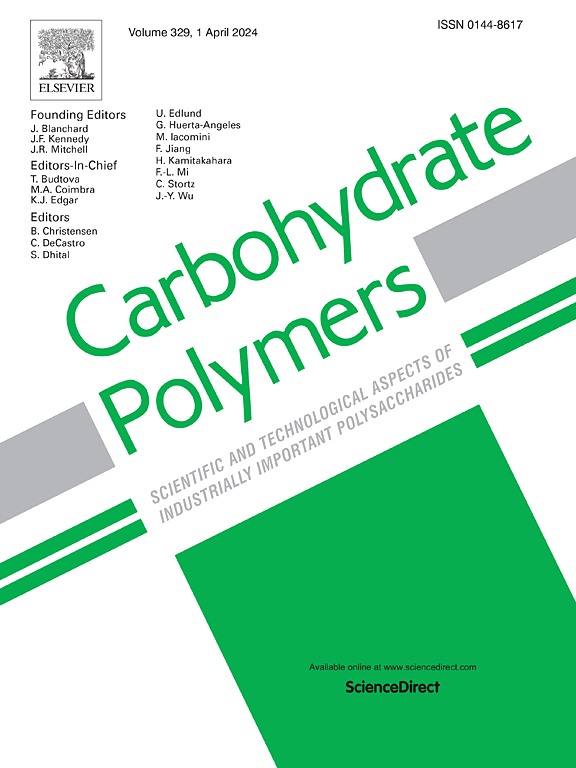脱支玉米淀粉对负载脱支淀粉-单宁配合物的普鲁兰/明胶纳米纤维的影响
IF 10.7
1区 化学
Q1 CHEMISTRY, APPLIED
引用次数: 0
摘要
葡萄籽单宁是酿酒的副产物,由于其高酚含量而具有丰富的抗氧化活性。在这项研究中,单宁与三种玉米淀粉(高直链玉米淀粉、普通玉米淀粉和糯玉米淀粉)的脱支淀粉配合。将淀粉-单宁配合物进一步掺入到普鲁兰/明胶纳米纤维中,得到抗氧化复合纳米纤维膜。研究了脱支淀粉-单宁配合物在纳米纤维中的掺入特性。结果表明,长链直链-单宁配合物具有v型和b型晶体结构,而短链直链-单宁配合物仅具有b型晶体结构。经包封后,与短链直链-单宁配合物相比,负载长链直链-单宁配合物的纳米纤维具有更高的单宁承载能力(2.54±0.06%),较慢的单宁释放速度(18.2%)和更好的力学性能,杨氏模量为233.7±36.3 MPa,断裂伸长率为15.4±0.6%,抗拉强度为18.2±0.9 MPa。本研究通过静电纺丝了解了去支淀粉如何影响淀粉-单宁复合物在抗氧化食品包装中的应用。本文章由计算机程序翻译,如有差异,请以英文原文为准。

Influence of debranched maize starch on pullulan/gelatin nanofibers loaded with debranched starch-tannin complexes
Grape seed tannins, the by-products of wine-making, are rich in antioxidant activity due to their high phenolic content. In this study, tannin was complexed with debranched starch from three types of maize starch (high amylose maize starch, normal maize starch and waxy maize starch). The starch-tannin complexes were further incorporated into pullulan/gelatin nanofibers to obtain an antioxidant composite nanofibrous film. The characteristics of debranched starch-tannin complexes were examined for incorporation into nanofibers. As a result, the long-chain amylose-tannin complexes exhibited V-type and B-type crystalline structure, while the short-chain amylose-tannin complexes showed exclusively B-type crystalline structure. After encapsulation, nanofibers loaded with long-chain amylose-tannin complexes demonstrated significantly higher tannin loading capacity (2.54 ± 0.06 %), slower tannin release (18.2 %) and better mechanical properties, with Young's modulus of 233.7 ± 36.3 MPa, elongation at break of 15.4 ± 0.6 % and tensile strength of 18.2 ± 0.9 MPa, compared to those loaded with short-chain amylose-tannin complexes. This study provided an understanding of how de-branched starches influenced the potential of starch-tannin complexes for use in antioxidant food packaging through electrospinning.
求助全文
通过发布文献求助,成功后即可免费获取论文全文。
去求助
来源期刊

Carbohydrate Polymers
化学-高分子科学
CiteScore
22.40
自引率
8.00%
发文量
1286
审稿时长
47 days
期刊介绍:
Carbohydrate Polymers stands as a prominent journal in the glycoscience field, dedicated to exploring and harnessing the potential of polysaccharides with applications spanning bioenergy, bioplastics, biomaterials, biorefining, chemistry, drug delivery, food, health, nanotechnology, packaging, paper, pharmaceuticals, medicine, oil recovery, textiles, tissue engineering, wood, and various aspects of glycoscience.
The journal emphasizes the central role of well-characterized carbohydrate polymers, highlighting their significance as the primary focus rather than a peripheral topic. Each paper must prominently feature at least one named carbohydrate polymer, evident in both citation and title, with a commitment to innovative research that advances scientific knowledge.
 求助内容:
求助内容: 应助结果提醒方式:
应助结果提醒方式:


